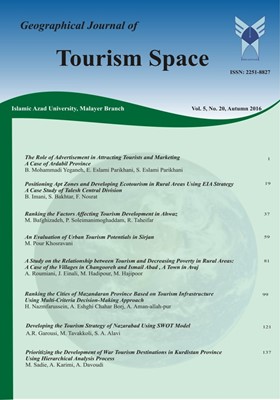A Study on the Relationship between Tourism and Decreasing Poverty in Rural Areas:A Case of the Villages in Changooreh and Ismail Abad , A Town in Avaj
Subject Areas :
Keywords: Tourism, Rural Development, rural, Rural poverty, Ismail Abad, Changooreh,
Abstract :
The aim of this study was to investigate the role of tourism and its impact on decreasing rural poverty in the areas of Ismail Abad and Changoureh villages in Hesar Valiasr located in Buin Zahra. The study is an applied one as far as the aims are concerned and is a descriptive/analytical study since its method is considered. Library research including questionnaire, observation and interview were used to obtain the required data. For data analysis, a descriptive and inferential statistical method (a t-test, one example Friedman and multiple regression analysis) was used. The results of the study showed that there was a positive and statistically significant relationship between tourism and poverty decrease in the area under study. So, in the physical dimensions the poverty decrease leads to changes in many rural constructions, improvement of roads, paving the streets, road communication infrastructure development, and so on. Also, as the economic dimensions are concerned, the poverty decrease fosters non-agricultural job creation activities, improving infrastructure services, diversified sources of household income and the increase in the household savings opportunities, and finally the development of entrepreneurial activity. As far as the social dimension is regarded, it can lead to reducing migration of residents especially the youth, creating empathy among the villagers and tourists, strengthening the local institutions, and changing the values caused by the presence of tourists and local people. It was also recommended that the mentioned dimensions may cause some changes in the environment such as change in land use, in farmlands and orchards, unplanned construction, destruction of natural beauties, degradation of rangelands and wildlife habitats, and finally water pollution.

